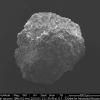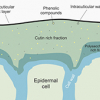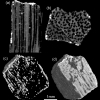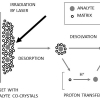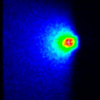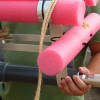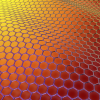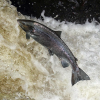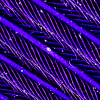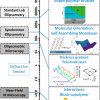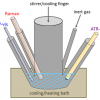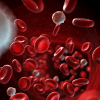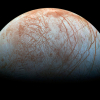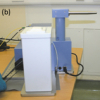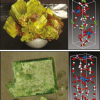Articles
Several earthworm species secrete very small granules of calcium carbonate, and the authors think these are involved in pH regulation. These granules contain different polymorphs of calcium carbonate, including the amorphous form which is very unstable in the laboratory. To investigate this they have FT-IR spectroscopy and mapping, and are continuing this work with Ca XANES.
Much of the exterior surface of plants is covered by the cuticle. This plays a vital role in protecting the plant from water loss, attack by pests and pathogens and damage from UV radiation. Infrared spectroscopy is very useful in characterising cuticles, as we learn in “Infrared spectroscopy as a tool to study plant cuticles” by José Heredia-Guerrero, José Benítez, Eva Domínguez, Ilker Bayer, Roberto Cingolani, Athanassia Athanassioua and Antonio Heredia. The authors point out that, whilst still in its early stages, infrared spectroscopy has provided valuable information about the functional groups, chemical structure and arrangement and interactions of plant cuticle components.
Dates and fates of pyrogenic carbon: using spectroscopy to understand a “missing” global carbon sink
Research into climate change takes many directions, but storing carbon or understanding its release from stores is extremely important. Pyrogenic carbon comes from the incomplete burning of biomass, and can be natural, e.g. wild fires, or man-made, e.g. the production of charcoal. The authors describe the uses of a range of spectroscopy techniques to understand the molecular structure of pyrogenic carbon and its role in the global carbon cycle.
The bio theme moves to mass spectrometry in “Solid mixed matrices and their advantages in matrix-assisted laser desorption/ionisation time-of-flight mass spectrometry” by Marek Šebela. Getting the most from various matrices for use in matrix-assisted laser desorption/ionisation (MALDI) has always been a bit of an art, and the introduction of mixed matrices may increase the number of possible combinations but may improve reproducibility and so simplify analysis in the end. The author describes mixed matrices for a range of samples including proteins, peptides, oligosaccharides, oligonucleotides, lipids, polymers and even intact microbial cells!
As you will have noticed from this issue’s cover, we are making a colourful start to 2016. In the first article on “The analytical niche for Raman spectroscopy in biological pigment research”, Daniel Thomas and Cushla McGoverin suggest that Raman spectroscopy may have a particularly valuable role in pigment biology research. Pigments are almost universal in biology and are the basis of much of what we find attractive in flowers, birds and sea life, such as the fan corals on the cover. The authors show how Raman spectroscopy can be used to quickly confirm the presence of a pigment as well as providing more detailed knowledge about unknown pigments.
Another surface problem is tackled by Richard Pilkington, Stuart Astin and John Cowpe: “Application of laser-induced breakdown spectroscopy for surface hardness measurements”. Measuring the hardness of materials is not entirely straightforward, and the authors show that laser-induced breakdown spectroscopy offers the potential for in situ hardness measurements, without prior sample preparation.
This article tells us about another: “Fast and versatile ambient surface analysis by plasma-assisted desorption/ionisation mass spectrometry”. They show that surface analysis can greatly benefit from approaches using surface–plasma interactions and that PADI shows significant promise to become a valuable and versatile tool for this.
To ensure that the removal and treatment of our sewerage meets increasingly high standards, it is important to be able to monitor the water online both to provide timely information and also to establish changing patterns over days, weeks and seasons. In their article “On-line monitoring for improved wastewater system management: applications of ultraviolet/visible spectroscopy”, Rita Brito, Rita Ribeiro, Tatiana Arriaga, Catarina Leitão, Nìdia Lourenço, Filipa Ferreira and Helena Pinheiro demonstrate the value of on-line UV/vis spectroscopy for wastewater quality monitoring in decentralised wastewater treatment and for spectral on-line monitoring of key quality parameters at the inlet to wastewater treatment plants.
Graphene has been receiving a large amount of interest as its commercial possibilities begin to be realised. Now, with hundreds of companies offering commercial graphene production, analytical measures of graphene quality are required. Raman spectroscopy can be used to “understand the number of layers, strain, doping and importantly the level of disorder present in graphene”, which is described in this article: “Graphene characterisation and standardisation via Raman spectroscopy” by Andrew Pollard and Debdulal Roy.
Fine sediments, often due to run-off from the land, can clog the surface and sub-surface spaces in gravel beds used by spawning fish to lay their eggs and by aquatic insects. Without an adequate flow of oxygenated water, the eggs and insects die. Heather Haynes, Susithra Lakshmanan, Anne-Marie Ockelford, Elisa Vignaga and William Holmes tells us about this in “The emerging use of magnetic resonance imaging to study river bed dynamics”. They have studied the infiltration of various sediments into model gravel beds both outside and flowing through a MRI instrument! They conclude that MRI “provides an exciting opportunity to unravel a plethora of processes relevant to wider environmental science”.
Jürgen Gross has been using ambient mass spectrometry to look at the presence of polydimethylsiloxanes (PDMS) in food prepared in silicone rubber objects and on baking parchment. He shows that PDMS migrates into the food, something perhaps we should think about if in the mood for some baking!
Stanislav Strekopytov tells us about “The use of inductively coupled plasma mass spectrometry to quantify chemical hazards in natural history collections: arsenic and mercury in taxidermy bird specimens”. It is quite shocking to learn about the use of poisons to preserve taxidermy specimens in the past. Nowadays it is essential that the dangers from such specimens are known before they can be handled by museum staff and particularly if they might be touched by visitors. ICP-MS analysis provides fully quantitative information on bulk contents of toxic elements in taxidermy specimens and so is well suited to this task.
Mark Tobin and colleagues describe “Fourier transform infrared spectroscopy and imaging of dragonfly, damselfly and cicada wing membranes”. Insects and plants have evolved highly specialised surfaces such as being highly water repellent or superhydrophobic, which also confers self cleaning properties. This is of interest to materials scientists to help in the development of manufactured materials with similar properties. High spatial resolution FT-IR spectroscopy and imaging provide useful information about the complex chemical patterning that contributes to this functionality.
The authors describe “Infrared mapping spectroscopic ellipsometry”. Recent developments in fundamental and materials research have increased the value of mapping techniques such as ellipsometry. IR ellipsometry, since it operates in the mid-IR fingerprint region, provides complementary information on composition, structural properties and interactions
In situ spectroscopic methods such as infrared, Raman and UV/vis spectroscopy are powerful tools to gain insight into reaction mechanisms and catalyst actions in homogeneously catalysed reactions. These methods and combinations of them offer great potential for the real-time monitoring of reactions in the liquid phase, for mechanistic studies as well as process control and kinetics.
Research is under way as to the possibility of using high-precision isotopic analysis of metals in a biomedical context. The goal is to develop methods for medical diagnosis on the basis of isotopic analysis of mineral elements in biofluids, for diseases that can otherwise only be established at a later stage or via a more invasive method (e.g., a biopsy) and/or for prognosis purposes. Whilst this work is in a very early stage, it is known that various diseases have an influence on the uptake, metabolism and/or excretion of essential mineral elements and thus, can cause a difference in their isotopic composition in biofluids.
Christian Schröder tells us about “Mössbauer spectroscopy in astrobiology”. Iron is abundant in the Earth’s crust, as well as on Mars and is likely to be so also on Jupiter’s moon, Europa. Iron is important for life and may have played a role in the origin of life as an energy source and by providing mineral surfaces as a template for surface metabolism. Iron continues to be essential for almost all organisms as the functional centre of many proteins and enzymes. Mössbauer spectroscopy is a powerful tool to study iron-bearing solid substances and as such has applications in the search for life in other parts of our Solar System.
“In vivo Raman spectroscopy of skin” is Paul Pudney’s topic. The skin is a most important part of our bodies. There is great interest in studying it to help understand the many skin diseases we are prone to, including cancer, to develop skin care products and, increasingly, as an alternative route to administer pharmaceuticals instead of through the gut. Raman spectroscopy is an excellent tool to study these, and has particular advantages in its ability to do so in vivo.
Sampling on important works of art is not possible and this is the main reason why only non-invasive techniques, such as MSI, are becoming increasingly popular to assist with undertaking conservation decisions.
The “Application of Raman and photoluminescence spectroscopy for identification of uranium minerals in the environment” is described by Eric Faulques, Florian Massuyeau, Nataliya Kalashnyk and Dale Perry. Uranium forms a large number of compounds and complexes, and these are most helpful in the study of uranium, its chemistry and transport in the environment. Raman and photoluminescence spectroscopy provide complementary information and are powerful tools for direct speciation of uranium and identification of natural uranyl minerals relevant to the environment.

